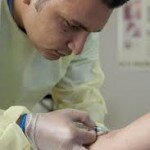Would you be interested in working in a robust recession-proof field that is embedded in the health care industry, which means that you will routinely provide medical care and assistance to patients? Do you possess sound dexterity and the willingness to work in challenging and high pressure circumstances? Do you want a career in the medical field without having to face extensive and exhaustive classroom education and clinical training? You may want to consider pursuing a rewarding career in phlebotomy. As a phlebotomist, you will take, analyze and handle blood samples from patients. It is important that you are very focused and precise when working as a phlebotomist. You will develop critical skills in phlebotomy through clinical rotations. While it does not take too long to complete your phlebotomy training, you will need to successfully complete clinical rotations. Let’s take a look at what you can expect.
 During your series of clinical rotations in phlebotomy training, you can expect to work in a hospital or lab setting to perfect your understanding and ability to carry out important procedures in the field. You will absolutely practice completing venipunctures during your clinical rotations in phlebotomy training. With this important procedure, you will insert a safety needle into a patient’s vein and then you will attach the needle to tubes so that blood can be collected. It is important that you collect the proper amount of blood, apply proper pressure to the wound bandage it appropriately. This is the most common procedure involved in phlebotomy and you will learn more about it during your clinical rotations. The finger stick is another important procedure you will practice during clinical rotations. With this procedure, you prick the index finger, heel or foot of patients to draw blood. You can also expect to learn about the techniques and technology involved in analyzing blood samples, important safety protocol and proper ways to store blood.
During your series of clinical rotations in phlebotomy training, you can expect to work in a hospital or lab setting to perfect your understanding and ability to carry out important procedures in the field. You will absolutely practice completing venipunctures during your clinical rotations in phlebotomy training. With this important procedure, you will insert a safety needle into a patient’s vein and then you will attach the needle to tubes so that blood can be collected. It is important that you collect the proper amount of blood, apply proper pressure to the wound bandage it appropriately. This is the most common procedure involved in phlebotomy and you will learn more about it during your clinical rotations. The finger stick is another important procedure you will practice during clinical rotations. With this procedure, you prick the index finger, heel or foot of patients to draw blood. You can also expect to learn about the techniques and technology involved in analyzing blood samples, important safety protocol and proper ways to store blood.
If you have chosen to pursue a career in phlebotomy, feel confident knowing that you have chosen a field that boasts strong job prospects and is embedded in the health care industry, which means you will provide real medical service to patients. You must complete rigorous clinical rotations during your phlebotomy training. You will understand how to properly perform such procedures as venipunctures and finger stick. You will also be exposed to the technology in analyzing blood samples as well as important safety protocol.


